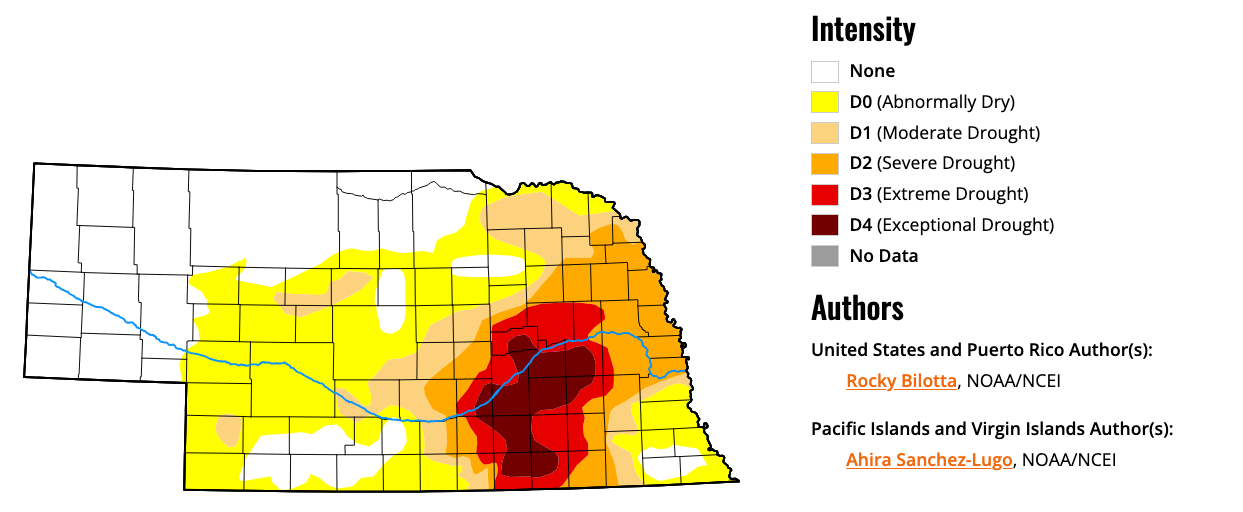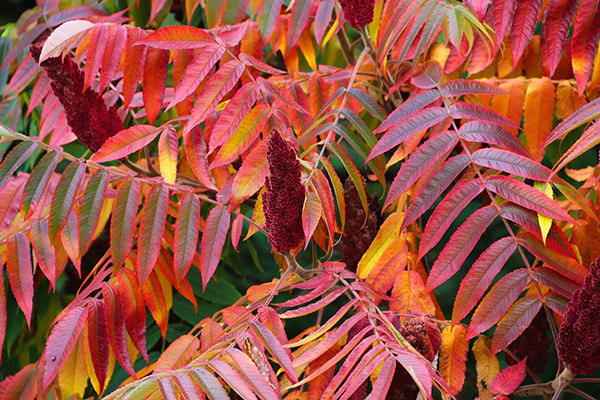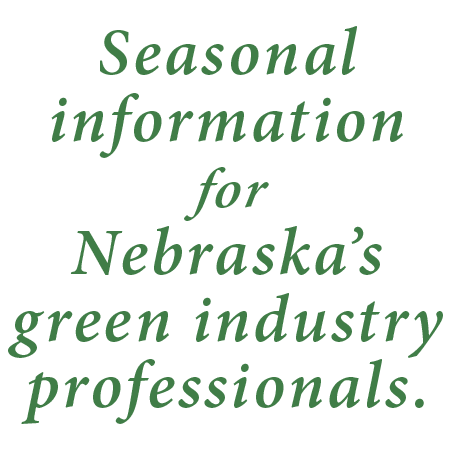How are we doing?
The Hort Update team strives to provide horticulture professionals with timely, relevant information from research-based sources. Complete a short survey and let us know how we can make Hort Update even better. Your feedback is greatly appreciated! Survey
| Serious Concerns | Major Symptom: |
|---|---|
| 1. Phosphorus and soil testing | Use soil tests to determine need for additional phosphorus |
| Minor Issues | |
| 2. Nuisance home invading pests | Insects, spiders, mice - exclusion best means of control |
| 3. Cluster flies in the home | Nuisance fall invader; winter control |
| 4. Wildlife damage prevention | Prevention is best; visit wildlife.unl.edu for additional information |
| Timely Topics | |
| 5. Dormant seeding | Prepare site now; seed after Thanksgiving or into early March |
| 6. Mowing tree leaves into turf | Up to 3-inches of leaves can be mowed into turf at one mowing; up to time 6-inches (or more) for the fall season |
| 7. Don't scalp turf going into winter | Scalped turf more susceptible to winter kill |
| 8. Preparing roses for winter | Fall pruning can increase winter injury |
| Heads Up: For Your Information | |
| 9. ProHort Lawn & Landscape Update - Fall virtual program | Mark your calendars for November 9, 10:00 am to Noon CST; agenda and registration available at Go.unl.edu/prohort |
| 10. Commercial/Non-commercial pesticide applicator certification | Obtaining a new license or updating an expired license |
| 11. Digital Diagnostic Network - Need help with diagnostics? | Submit pictures and questions for diagnosis by Nebraska Extension experts |
Nebraska's drought status, 10/26/23 Map updated weekly.

1. Phosphorus and soil testingUse soil tests to determine need for additional phosphorus
Soil tests should be used to determine the need for phosphorous in fertilizer applications for the following reasons.
- Phosphorous (P) is an essential nutrient and should be applied if needed.
- Nebraska lawn and landscape soils tend to test Adequate-High for P; and movement of this nutrient in soil is low, unlike nitrogen which is quite mobile. If not needed, P should not be applied.
- Negative environmental impact of excess P is well documented, especially for water quality.
- The build-up of P in soil can lead to poor plant growth.
Pros & Cons of Additional Phosphorus
Phosphorous (P) is one of the macronutrients essential to plant growth. It promotes root growth, hardiness, above ground shoot growth and has other key roles in plant growth. Application of P is often encouraged when establishing new plants; starter fertilizers high in P are frequently sold along with new plants.
However, phosphorous is the main nutrient, along with nitrogen, promoting excess algal growth in surface water leading to impaired water quality. It enters water through soil erosion, wind erosion of soil, run-off of fertilizer and plant debris from lawns and ag fields, faulty septic systems, and animal waste. It is unclear how much each of these P sources contribute to negative water quality, but excessive use of P fertilization as a pollution source is a factor that can be controlled.
Effects of Very High Soil Phosphorus on Plant Growth
The build-up of P in soils can lead to poor plant growth. According to Texas A&M Extension, excessive soil phosphorus reduces the plant's ability to take up required micronutrients, particularly iron and zinc, even when soil tests show there are adequate amounts of these nutrients in soil. This can result in iron and zinc deficiencies exhibited by leaf yellowing between leaf veins for iron (chlorosis) or a bleaching of tissue for zinc.
Determining Current Soil Phosphorus Levels
A soil test is the best way to determine the need for phosphorous application. Two different tests are used to determine available soil phosphorous. The Bray-P1 test is used when soil pH is 7.4 or less and the Olsen-P test is used when soil pH is greater than 7.4. The reading will come back as parts per million (ppm). For example, the University of Minnesota states 20 ppm is sufficient for lawns.
Fall is a good time to test soil. Soil testing every few years is wise to base soil management and fertilization decisions on. There are a number of soil labs in Nebraska - A list of labs and information on taking soil samples can be found at Soil Testing for Turf Areas.
Basic soil tests are inexpensive, about $15 to $20, and sampling is easy. A basic soil test measures pH, organic matter content, cation exchange capacity (CEC) and levels of nutrients like nitrogen, phosphorus and potassium among other things. Check out Simplifying Soil Test Interpretations for Turf Professionals for help in interpreting test results.
Additional resources:
- Facts About Phosphorous and Lawns, Purdue Extension
- Phosphorous: Too Much and Plants May Suffer, Texas A&M AgriLife Extension
- Soil Test Interpretations and Fertilizer Management for Lawns, Turf, Gardens and Landscape Plants, University of Minnesota Extension
2. Nuisance home invading pestsInsects, spiders, mice - exclusion best means of control
These pests may enter homes in fall as temperatures cool and they begin to look for overwintering sites. Pests like boxelder bugs, millipedes and Asian lady beetles are common. Most are harmless but still a nuisance.
Exclusion is the best means of reducing nuisance pests and mice indoors. Caulk cracks, crevices and conduits of the home. Repair window screens and check that doors are tight fitting. If needed, insecticides can be applied to building foundations according to label direction. Ideally, apply the insecticide from the foundation out to five to 10 feet.
- Accidental and Occasional Invaders, Nebraska Extension
- Insects That Overwinter in Your Home, Nebraska Extension
- Keeping Occasional Invaders Out, Nebraska Extension
- Boxelder Bugs, Nebraska Extension
- Controlling House Mice, Nebraska Extension
- Identification Guide to Common Spiders in Nebraska, Nebraska Extension
- Millipedes, Nebraska Extension
- Multi-colored Asian Ladybird Beetles, Nebraska Extension
3. Cluster flies in the homeNuisance fall invader; winter control
Cluster flies, also called attic flies, are a nuisance fall invader. These flies are slightly larger than house flies and fly sluggishly, making them easier to swat. Unlike many flies whose larvae feed on dead things, cluster fly larvae feed within earthworms after adults lay eggs in soil cracks. Until fall arrives and adults begin looking for overwintering sites, these flies largely go unnoticed.
As with most nuisance invaders, the best management tactic is to caulk or fill cracks and crevices around homes. Before cluster flies move indoors for overwintering, treatments can be applied to upper stories of building exteriors for fly control. When flies become active during sunny days in winter, insecticide bombs containing permethrin may be useful in attics or other rooms which can be isolated from the rest of the house, and if the attic is NOT over a room where food is prepared. Consult the label for safe application information and reentry times.
Cluster Flies, Nebraska Extension
4. Wildlife damage preventionPrevention is best; visit wildlife.unl.edu for additional information
It’s the time of year to prepare for protecting landscape plants from wildlife damage during winter. When green foliage is no longer present, wildlife often turn to other plant parts, such as tree bark and inner wood of young trees. This type of feeding causes damage that is more harmful to plants in the long run.
- Managing Deer Damage in Nebraska, Nebraska Extension
- Managing Rabbit Damage, Nebraska Extension
- Excluding Rabbits, Backyard Farmer
- Controlling Vole Damage, Nebraska Extension
- Vole Control, Backyard Farmer
5. Dormant seedingPrepare site now; seed after Thanksgiving or into early March
The best time to seed cool season turfgrass is mid-August into mid-September, but dormant seeding can also be very successful. Dormant seeding is defined as such because seed lies dormant until soil temperatures warm in April or May. Dormant seeding can be done as early as Thanksgiving or as late as March in most locations. The key is to seed after the soil is cold enough that germination will not occur until after soils warm in spring. The benefit of dormant seeding is as soil heaves and cracks during winter, crevices are created for seed to fall into, providing ideal germination conditions in spring. Dormant-seeding may be easier to schedule than spring seeding, because spring rains can make it difficult to seed after March.
There are risks with dormant seeding. It is most effective if weather remains cold enough to delay germination until spring. Occasionally, extended warm periods in winter could allow seed to germinate, and seedlings may then be killed by ensuing cold weather. As with any seeding, soil preparation needs to be done prior to seeding. For dormant seeding, this would be in fall before the soil freezes. If using dormant seeding, monitor the area in mid spring for the need to do additional over-seeding.
Establishing Lawns from Seed, Nebraska Extension Turf iNfo
6. Mowing tree leaves into turfUp to 3-inches of leaves can be mowed into turf at one mowing; up to time 6-inches (or more) for the fall season
While many homeowners bag tree leaves each fall, most professional turf managers mulch mow leaves. Mulch mowing can be easier and returns complex organic matter and nutrients to the soil. Some research suggests mulch mowing can even help control weeds. While this weed control benefit can be sporadic, it can help improve the health of your lawn and soil. The ground tree leaves won’t add to thatch.
Mulching leaves is also easier and less time consuming than bagging. Sometimes a double mowing at a slightly higher cutting height will help shred those leaves and bury them in the lawn. Six inches or more of leaves, in total for the fall season, can be mulch mowed into turf. This doesn't mean letting the leaves accumulate into one thick layer before mowing, but mowing several times to incorporate shallower layers of leaves - ideally no more than 3" of leaves at a time. Chopped leaves should filter down into the grass canopy during mowing. As long as the chopped leaves are not starting to accumulate on top of the turf and shading out the plants beneath, then you haven't tried to mulch mow too thick a leaf layer. If this occurs, then make as many passes as needed to continue breaking down the leaves, spreading them out and enabling them to filter down into the grass canopy.
When mowing leaves don’t allow them to lay on the street or other concrete surfaces. Leaves leach nutrients which pollute waterways or can be carried to surface water through storm drains where they release nutrients leading to algal problems.
But, sometimes tree leaves come too fast and quickly pile over the lawn. If homeowners need to rake and bag, encourage them to compost those leaves.
7. Don't scalp turf going into winterScalped turf more susceptible to winter kill
Scalping occurs when more than one-third of the turf's foliage is removed at one time, often exposing the stems of the grass plants, resulting in stress and even plant death. Removal of 50% or more of the turf canopy at one mowing results in severe defoliation.
Some homeowners still like to lower their mowing height in fall as a way to "clean up" the turf at the end of the season. Lowering the mowing height from a 3.5" standard summer mowing height to 2" fall "clean up" height would result in scalping. Turf, which may already be drought-stressed due to ongoing dry fall conditions, could ultimately suffer grass thinning or death during winter. Advise clientele not to lower their mowing height for an end-of-season clean up mowing. It is better to maintain the same mowing height all season.
8. Preparing roses for winterFall pruning can increase winter injury
Research has shown roses sustain less winter injury if they are not pruned in fall, but instead in spring the following year right before new growth begins. Pruning earlier, including fall pruning, can increase winter injury.
To prepare roses for winter, now is the time to clean up old leaves to reduce overwintering organisms. For hybrid tea roses, or others particularly susceptible to winter injury - thus requiring extra winter protection - don't put rose cones in place too early. Wait until after two or three hard freezes before applying winter protection to insure the rose is fully dormant. This is a plant's best protection against cold temperature. When putting the rose cone in place prune only as needed to get the cone in place. Leave additional pruning for next spring.
Shrub roses can also be pruned in early spring to remove any dead stems.
10. Commercial/Non-commercial pesticide applicatorsObtaining a new license or updating an expired license
If you have a pesticide applicators license which expired in April 2023 or you need to get a new license, testing options are listed below.
Testing-only Options
- Closed-book exams are given by the Nebraska Department of Agriculture (NDA). Preregistration is not required an there is no cost. Visit the link below for a list of available test-only dates, times and locations - https://pested.unl.edu/.
- NDA computer-based testing is provided through the Pearson-Vue company. Click here for a list of testing sites, categories available, dates, and registration information. Cost $55 per exam. (For applicators with multiple categories on their license, each category is charged the full testing fee.)
2024 Commercial/non-commercial training is held from January through April. Training schedules will be available soon at https://pested.unl.edu/. Help your employees be successful at getting a license by purchasing study materials.
Extension and industry-sponsored events also offer opportunities to renew a license. Recertification only.
- Nov. 30th | Midwest Grain Seminar: Grain Storage & Fumigation Training - 00 general standards, 11 fumigation
- Jan. 3-23 | Nebraska Extension Crop Production Clinics - 00 general standards, 01 ag plant, demonstration/research
- Jan. 9-11 | Nebraska Turf Conference - 00 general standards, 04 turf & ornamental
- Feb. 19-21 | Nebraska Aviation Trades Association Convention - 00 general standards, 01 ag plant, 07 right-of-way, 09 public health, 12 aerial
- Feb. 21-23 | Nebraska State Pest Control Association Conference - 00 general standards, 08 structural/health related, 08w wood destroying organisms, 11 fumigation, 14 wildlife damage control
Commercial/noncommercial applicators are professionals who apply restricted-use pesticides for hire or compensation. Anyone who applies pesticides to the property of another person, either restricted- or general-use products, for control of pests in lawns, landscapes, buildings or homes must also have a commercial pesticide applicators license. Public employees (those employed by a town, county, state) applying mosquito control pesticides whether restricted- or general-use, must also hold a commercial or noncommercial certification.
11. Digital Diagnostic Network - Need help with diagnostics?Submit pictures and questions for diagnosis by Nebraska Extension experts
Do you or your clients have questions you need help answering? Maybe you are a lawn care person and they're asking about trees, shrubs, or flowers? While you can refer them to their local Extension office, another option is Digital Diagnostic Network. Homeowners, lawn care professionals, pest control operators and others are invited to submit questions and photos through this website or with the assistance from an Extension professional at any Nebraska Extension office. All offices are equipped with high-resolution digital image capturing technology. Whether the question is about a lawn weed, insects on a plant, diseases in a shrub border or other, an expert panel of Extension professionals will review and respond to the question. To get started, create an account so the question can be reviewed and responded to via email. For more information and to create an account, go to Digital Diagnostic Network.
Bugging Out With Your Camera Phone - Tips on how to get a good picture.
Reference to commercial products or trade names is made with the understanding that no discrimination is intended and no endorsement by Nebraska Extension is implied. Use of commercial and trade names does not imply approval or constitue endorsement by Nebraskas Extension. Nor does it imply discrimination against other similar products.

